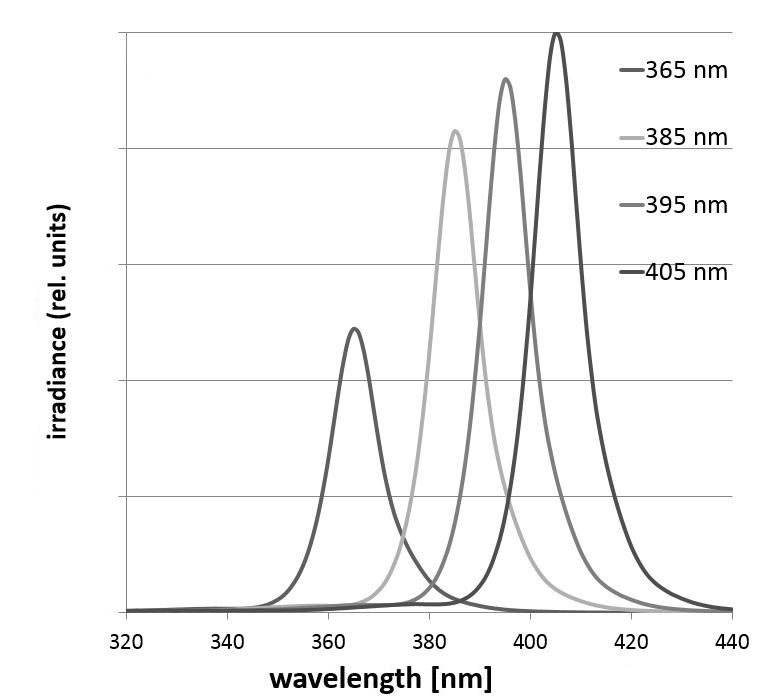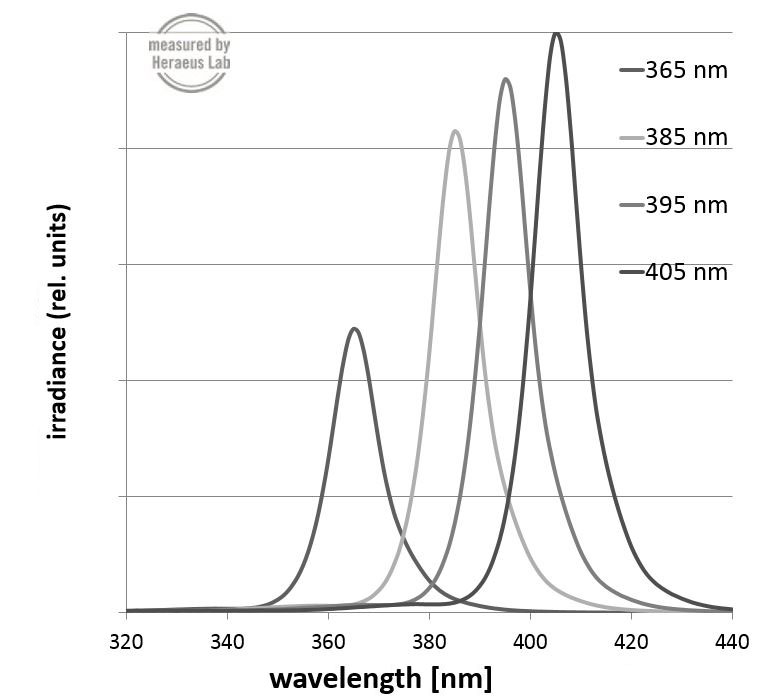Commercial use of UV LED curing technology is advancing at a rapid pace due to improvements in energy output and increasing availability of ink, adhesive, and coating chemistry formulations. The intensity output of UV LEDs is increasing at a rate of 12% annually!
This means applications like converting that require faster production speeds are now becoming feasible.
This article provides process design and development engineers with a brief introduction to UV LED curing, benefits for converting production lines, and next steps to ensure you stay ahead of your competition.
Improving Converting Curing Processes with UV LED Curing

UV LED Output

Unlike traditional UV curing which has a broad spectrum output, the output of UV LEDs for curing is currently available in one of four narrow, nearly monochromatic, wavelengths – 365, 385, 395 and 405 nm.
While this means less wasted output (unneeded or unusable wavelengths), it also means chemistry formulators may need to develop new chemistries responsive to these specific wavelengths while still delivering the specific coating or adhesive requirements.
Some applications such as laminating adhesives already use longer wavelength additive, or “doped”, arc lamps, since shorter wavelengths get absorbed by the film. So laminating is a natural fit for using UV LED curing now.
Commercial UV LED curing
Currently, UV LED curing is being used commercially for graphic arts printing applications such as digital inkjet, flexographic, and offset sheet-fed printing as well as industrial inkjet marking/coding, adhesive bonding, sealing, screen print decorating, electronics encapsulating and potting, and photoresist applications.
Retrofitting converting lines which have existing UV curing systems to UV LED curing systems (in addition to or as a replacement) is inevitable for certain application given the significant process improvements and resulting bottom line business benefits available.
Process design and business benefits of UV LED curing
Compared to existing UV curing technology UV LED curing systems offer more uptime due to their significantly longer life and instant on/off capability. UV LEDs operate up to 10 times longer (10,000+ hours) than arc UV curing systems.
The instant on/off capability of UV LEDs means no more waiting to restart a line or deal with maintenance prone shutters as is required with arc UV lamps. More uptime results in higher production rates.
UV LED curing systems operate at much cooler temperatures than traditional UV curing making it possible to run heat sensitive materials without damaging them. Dimming controls mean you can dial in exactly the energy needed for changing process needs.
In addition to less product waste, this increased process flexibility and control can expand your production capabilities and deliver higher converting line utilization.
Assuming there is space on your line, adding UV LED to existing traditional UV curing can provide further flexibility and provide a production “test bed” before implementing on additional lines and plant locations.
The smaller form factor of UV LED curing systems makes them easy to retrofit onto existing converting production lines. In addition to their inherently small form factor, their low cooling and exhaust air requirements means there are no bulky and noisy external fans.
UV LEDs need cooling, but it’s done using either internal muffin-type fans or water cooling.
There is no need for shutters, and heat management and light shielding is greatly simplified. Finally, since there is no ozone generated (traditional UV lamps generate ozone from their short-wave output around 180 nm to 220 nm) or mercury in UV LEDs, the working environment is safer.
Today’s process designers need reliable and consistent UV curing processes that can be easily duplicated, or even relocated, anywhere across the globe. UV LED systems are significantly smaller and lighter, so relocating them is simpler and less costly than traditional UV curing.
And since UV LEDs need considerably less cooling air, converting lines located at higher or lower elevations won’t need significantly different cooling cfm. Even with inadequate cooling a UV LED will typically provide adequate output to meet process needs, though useful lifetime will likely be shortened. In contrast, traditional UV curing systems without adequate cooling typically overheat substrates, or their wavelength output changes enough to affect curing results, and operating life drops.
So UV LED curing provides a more reliable and consistent process no matter where it is located across your global manufacturing sites.
UV LED curing offers significantly lower operating costs compared to traditional UV curing due to energy savings, fewer consumable parts, and lower maintenance costs. UV LEDs typically use about 30 – 70% less energy compared to traditional UV curing.
Not having to keep consumable parts like lamps, magnetrons, ballasts, and reflectors on hand reduces costs. Lower maintenance results from less labor time spent replacing lamps and cleaning/servicing other parts such as ballasts, magnetrons, shutters, reflectors and fans.
Challenges
In the same way that LED technology has replaced some automotive lighting, interior lighting, and other traditional light sources, UV LED curing will inevitably replace traditional UV curing technology for some converting applications due to the advantages discussed here. Of course challenges remain for UV LED curing in commercial converting processes including finding suitable and available chemistry formulations. Converting applications such as optical films that require a hard coat are especially challenging for UV LED curing since short wavelengths, well below 365 nm, are needed for surface curing. Pairing UV LED curing with existing UV curing can be an ideal solution.
The most promising near term wide web converting applications for UV LED curing (development work, pilot lines and a few commercial lines using) are:
- laminating adhesives (film-to-film, film-to-foil, and film-to-paper)
- hydrogels (transdermal patches, etc.)
- processes where the UV energy can pass through one side of a substrate such as a transparent film to:
- reach the chemistry beneath
- create patterns (nanoimprint lithography) on the film.
And finally, with UV LED curing technology advancing so rapidly, it can be challenging to know when to adopt to gain the technology’s benefits yet avoid being stuck with outdated equipment.
Next steps
So what should converting process development and design engineers do now to avoid being left behind?
First, begin learning more about UV LED curing technology, equipment providers, and possible chemistry formulation partners to understand if UV LED is a fit for your converting processes, especially for laminating adhesive and other processes currently using longer wavelength additive lamps.
Second, build relationships now with experienced providers who can help you develop reliable and flexible UV LED curing processes via lab testing and in-plant trials. You’ll need partners who can help you assess when the timing is right for investing in UV LED curing for your converting processes.

